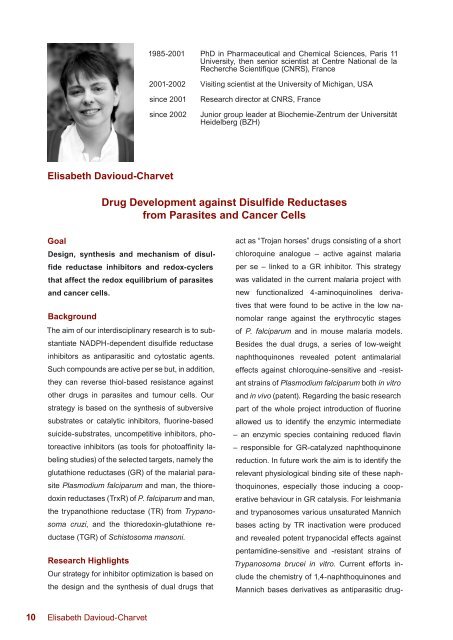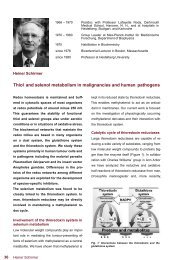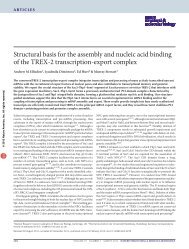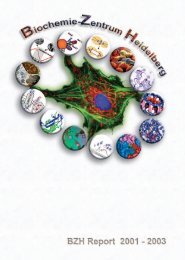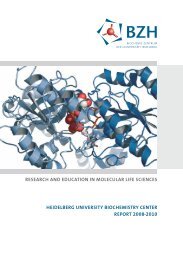Biochemie-Zentrum der Universität Heidelberg (BZH)
Biochemie-Zentrum der Universität Heidelberg (BZH)
Biochemie-Zentrum der Universität Heidelberg (BZH)
Create successful ePaper yourself
Turn your PDF publications into a flip-book with our unique Google optimized e-Paper software.
Elisabeth Davioud-Charvet<br />
Goal<br />
Design, synthesis and mechanism of disul-<br />
fide reductase inhibitors and redox-cyclers<br />
that affect the redox equilibrium of parasites<br />
and cancer cells.<br />
Background<br />
The aim of our interdisciplinary research is to sub-<br />
stantiate NADPH-dependent disulfide reductase<br />
inhibitors as antiparasitic and cytostatic agents.<br />
Such compounds are active per se but, in addition,<br />
they can reverse thiol-based resistance against<br />
other drugs in parasites and tumour cells. Our<br />
strategy is based on the synthesis of subversive<br />
substrates or catalytic inhibitors, fluorine-based<br />
suicide-substrates, uncompetitive inhibitors, photoreactive<br />
inhibitors (as tools for photoaffinity labeling<br />
studies) of the selected targets, namely the<br />
glutathione reductases (GR) of the malarial parasite<br />
Plasmodium falciparum and man, the thioredoxin<br />
reductases (TrxR) of P. falciparum and man,<br />
the trypanothione reductase (TR) from Trypanosoma<br />
cruzi, and the thioredoxin-glutathione reductase<br />
(TGR) of Schistosoma mansoni.<br />
Research Highlights<br />
Our strategy for inhibitor optimization is based on<br />
the design and the synthesis of dual drugs that<br />
10 Elisabeth Davioud-Charvet<br />
1985-2001 PhD in Pharmaceutical and Chemical Sciences, Paris 11<br />
University, then senior scientist at Centre National de la<br />
Recherche Scientifique (CNRS), France<br />
2001-2002 Visiting scientist at the University of Michigan, USA<br />
since 2001 Research director at CNRS, France<br />
since 2002 Junior group lea<strong>der</strong> at <strong>Biochemie</strong>-<strong>Zentrum</strong> <strong>der</strong> <strong>Universität</strong><br />
<strong>Heidelberg</strong> (<strong>BZH</strong>)<br />
Drug Development against Disulfide Reductases<br />
from Parasites and Cancer Cells<br />
act as “Trojan horses” drugs consisting of a short<br />
chloroquine analogue – active against malaria<br />
per se – linked to a GR inhibitor. This strategy<br />
was validated in the current malaria project with<br />
new functionalized 4-aminoquinolines <strong>der</strong>ivatives<br />
that were found to be active in the low nanomolar<br />
range against the erythrocytic stages<br />
of P. falciparum and in mouse malaria models.<br />
Besides the dual drugs, a series of low-weight<br />
naphthoquinones revealed potent antimalarial<br />
effects against chloroquine-sensitive and -resistant<br />
strains of Plasmodium falciparum both in vitro<br />
and in vivo (patent). Regarding the basic research<br />
part of the whole project introduction of fluorine<br />
allowed us to identify the enzymic intermediate<br />
– an enzymic species containing reduced flavin<br />
– responsible for GR-catalyzed naphthoquinone<br />
reduction. In future work the aim is to identify the<br />
relevant physiological binding site of these naphthoquinones,<br />
especially those inducing a cooperative<br />
behaviour in GR catalysis. For leishmania<br />
and trypanosomes various unsaturated Mannich<br />
bases acting by TR inactivation were produced<br />
and revealed potent trypanocidal effects against<br />
pentamidine-sensitive and -resistant strains of<br />
Trypanosoma brucei in vitro. Current efforts include<br />
the chemistry of 1,4-naphthoquinones and<br />
Mannich bases <strong>der</strong>ivatives as antiparasitic drug-


